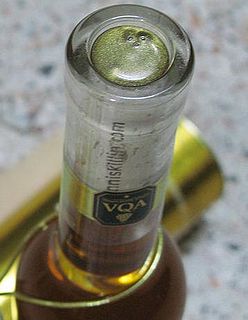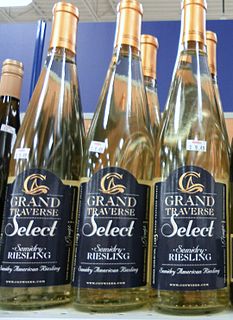
Prince Edward County is a single-tier municipality and a census division of the Canadian province of Ontario.

Vintners Quality Alliance, or VQA, is a regulatory and appellation system which guarantees the high quality and authenticity of origin for Canadian wines made under that system in British Columbia and Ontario. It is similar to regulatory systems in France (AOC), Spain (DO), Italy (DOC), and Germany (QmP). The VQA system allows for sub-appellations, by which the grapes for wines are sourced from extremely specific geographical locations with different soil and climate. This is in accordance with the concept of terroir.

Canadian wine is wine produced in Canada. Ontario and British Columbia are the two largest wine-producing provinces in Canada, with two-thirds of the Canada's vineyard acreage situated in Ontario. However, wine producing regions are also present in other provinces, including Alberta, Quebec, New Brunswick and Nova Scotia.

Michigan wine refers to any wine that is made in the state of Michigan in the United States. As of 2018, there were 3,050 acres (1,230 ha) under wine-grape cultivation and 148 commercial wineries in Michigan, producing 3 million US gallons (11,000,000 L) of wine. According to another count there were 112 operating wineries in Michigan in 2007.

Washington wine is wine produced from grape varieties grown in the U.S. state of Washington. Washington ranks second in the United States in the production of wine. By 2017, the state had over 55,000 acres (220 km2) of vineyards, a harvest of 229,000 short tons (208,000 t) of grapes, and exports going to over 40 countries around the world from the 940+ wineries located in the state. While there are some viticultural activities in the cooler, wetter western half of the state, the majority (99.9%) of wine grape production takes place in the shrub-steppe eastern half. The rain shadow of the Cascade Range leaves the Columbia River Basin with around 8 inches (200 mm) of annual rain fall, making irrigation and water rights of paramount interest to the Washington wine industry. Viticulture in the state is also influenced by long sunlight hours and consistent temperatures.
The state of Oregon in the United States has established an international reputation for its production of wine, ranking fourth in the country behind California, Washington, and New York. Oregon has several different growing regions within the state's borders that are well-suited to the cultivation of grapes; additional regions straddle the border between Oregon and the states of Washington and Idaho. Wine making began in the 1840s, with commercial production beginning in the 1960s.

New York wine refers to wine made from grapes grown in the U.S. state of New York. New York ranks third in grape production by volume after California and Washington. Eighty-three percent of New York's grape area is Vitis labrusca varieties. The rest is split almost equally between Vitis vinifera and French hybrids.

Ontario wine is Canadian wine produced in the province of Ontario. The provinces has three official wine-growing region, the Niagara Peninsula, the north shore of Lake Erie, and Prince Edward County, although wineries also exist in other regions in Ontario. Approximately two-thirds of Canada's vineyard acreage is situated in Ontario, with over 150 vineyards spread across 6,900 hectares. As a result, the province is the country's largest producer of wine, accounting for 62 per cent of Canadian wine production, and 68 per cent of all Canadian wine exports.
The Short Hills Bench is a sub-appellation of the Niagara Peninsula.

Barboursville Vineyards is a winery located in the Piedmont region of the Commonwealth of Virginia in the unincorporated community of Barboursville, Virginia. It is located within both the Virginia and Monticello viticultural areas.

The History of American wine began when the first Europeans explored parts of North America, which they called Vinland because of the profusion of grape vines found there. However, settlers would later discover that the wine made from the various native grapes, had flavors which were unfamiliar and which they did not like. This led to repeated efforts to grow familiar Vitis vinifera varieties. The first vines of Vitis vinifera origin were planted in Senecu in 1629, which is near the present day town of San Antonio, New Mexico.

The Old Mission Peninsula AVA is an American Viticultural Area located in Grand Traverse County, Michigan known for well-regarded Michigan wine. The Old Mission Peninsula extends northward from Traverse City into the Grand Traverse Bay of Lake Michigan, ending at Old Mission Point. The peninsula is 19 miles (31 km) long by 3 miles (5 km) wide at its widest point. The climate on the peninsula is moderated by the surrounding waters, helping to prevent frost during the growing season. Grape varietals suitable to cool climates, such as Riesling, Chardonnay, Gewürztraminer, Pinot gris, Pinot noir, Cabernet Franc, and Merlot do best in the Old Mission Peninsula AVA.

Inniskillin is a Canadian winery located in Niagara-on-the-Lake, Ontario. Inniskillin, which is mainly noted for its icewine production, has played an important pioneering role in the modern Canadian wine industry. Since 1994, Inniskillin also operates a winery in Okanagan, British Columbia in addition to its original location.

Depending on the province in which it is produced, Cellared in Canada is a category of Canadian wine that is produced with varying quantities of foreign bulk wine and Canadian wine. These wines are often sold in government-run liquor stores in sections designated as "Canadian wine". In British Columbia, Cellared in Canada wine may be produced from 100 percent foreign content with grapes grown from Washington State, California, South Africa, Argentina, Chile. and possibly even China. In Ontario, Cellared in Canada wine is allowed to be produced from a blend of no more than 60 percent foreign-sourced content. Within the 40 percent Ontario content, dilution with water is not allowed. The only indication of origin is found on the back of the bottle, with a term such as "Cellared in Canada from international and domestic wines". Other permitted terms are "Product of Canada" and "Vinted in Canada".

British Columbia wine is Canadian wine produced in the province of British Columbia. Wines made from 100 percent British Columbia grapes can qualify for classification under one of British Columbia's two classification systems, depending on the variety, the wine-making techniques employed, and various other restrictions.

Reif Estate Winery is located in Niagara-on-the-Lake in Ontario, Canada. Reif Estate is primarily known for playing an important in role pioneering the Ontario wine Industry, as well as planting some of the first Vitis vinifera vines in the Niagara region.

Nova Scotia wine is Canadian wine produced in the Canadian province of Nova Scotia. Nova Scotia's wineries are primarily organized under the Wine Association of Nova Scotia, though not all wineries are members. The industry began in the late 1970s with the original Grand Pré Winery in the Annapolis Valley of Nova Scotia.

Chateau Grand Traverse is a Michigan winery located in the Old Mission Peninsula AVA around Traverse City. The winery was founded by Edward O’Keefe Jr. and is notable for having the first large-scale planting of Vitis vinifera in Michigan. O'Keefe and Chateau Grand Traverse were also the driving force behind the establishment of an American Viticultural Area on the Old Mission Peninsula back in the 1980s when the estate was the only commercial winery on the peninsula. In 1980, the winery produced Michigan's first commercial ice wine and the 1987 vintage of Chateau Grand Traverse Johannisberg Riesling Ice Wine was served at the presidential inauguration of George H. W. Bush.

The Okanagan Valley wine region, located within the region of the same name in the British Columbia Interior, is Canada's second-largest wine producing area. Along with the nearby Similkameen Valley, the approximately 8,619 acres of vineyards planted in the Okanagan account for more than 80% of all wine produced in British Columbia, and are second in economic importance for wine production to the Niagara Peninsula of Ontario. Some 182 licensed wineries existed from south to north in the valley in 2018, with many situated along the 135 km (84 mi)-long Okanagan Lake and its tributaries and downstream lakes, including Skaha Lake, Vaseux Lake, and Osoyoos Lake. The Okanagan has diverse terrain that features many different microclimates and vineyard soil types, contributing characteristics which are part of an Okanagan terroir.

Bethel Heights Vineyard is an Oregon winery in the Eola-Amity Hills AVA of the Willamette Valley. Founded in 1977 by twin brothers Ted and Terry Casteel, their wives Pat Dudley and Marilyn Webb, and Pat's sister Barbara Dudley, the vineyard was one of the earliest plantings in the Eola-Amity Hills region. A winery soon followed, with the first estate wines produced in 1984. Bethel Heights specializes in Pinot noir, offering several individual block and vineyard designated bottlings, but also produces wines made from Chardonnay, Pinot gris, Pinot blanc, Riesling, Grüner Veltliner, and Gewürztraminer.















